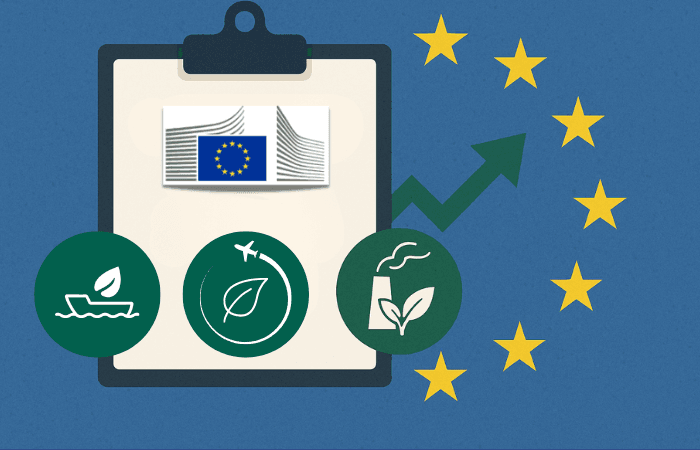EU Climate Regulations Explained
25 September 2025
The web of climate laws and policies in the EU can be confusing, so we’ve broken down the main EU climate regulations and looked at how they differ and how they fit together.
The Four Main EU Climate Instruments
1) EU ETS (Emissions Trading System)
- Type:
Cap-and-trade carbon market - Covers:
Power plants, heavy industry, intra-EEA aviation, maritime. With ETS2 adding road-transport and buildings via fuel suppliers from 2027. - How it works:
The EU sets a cap on allowances and covered operators must surrender one allowance per tonne of CO₂e emitted. The cap falls each year. - Penalty for non-compliance:
€100 per excess tonne (indexed to inflation), and you still owe the missing allowances. Maritime non-compliance can ultimately lead to trading bans.
2) Effort Sharing Regulation (ESR)
- Type:
Binding national targets for sectors outside the ETS (surface transport, buildings, agriculture, small industry, waste) ~60% of EU emissions - How it works:
Each state receives an annual emissions budget for 2021–2030 that declines over time. There are flexibilities to bank/borrow/trade allocations. - Non-compliance:
Excess emissions are carried over with a 1.08 multiplier (tightens the following year’s target) and the Commission can require corrective action plans. States can also purchase allocations from others.
3) LULUCF Regulation (Land Use, Land-Use Change and Forestry)
- Type:
Rules for the land and forest sink - Targets:
An EU-wide net removal of 310 Mt CO₂e by 2030, with national contributions. Stronger monitoring and compliance rules were added in the 2023 revision. - Non-compliance:
Similar to ESR logic – misses tighten subsequent requirements. There are flexibilities, including limited ESR/LULUCF interactions and transfers between Member States.
4) Renewable Energy Directive (RED III)
- Type:
Sets the binding EU-level renewables share for 2030, which is at least 42.5% (with an aspiration to 45%). Also includes sector-specific sub-targets and sustainability criteria. - Enforcement:
Implemented via national laws. If a country fails to transpose or deliver, the Commission can open infringement cases that may end at the EU Court of Justice with fines. This is general EU law enforcement rather than a single numeric “penalty” in the directive text.
How these Climate Regulations Sit Inside the Wider EU Climate Framework
European Green Deal
- The overall strategy to decarbonise the EU economy. The measures below are the main delivery tools.
(More: European Commission)
European Climate Law
- Makes net-zero by 2050 legally binding and sets the 2030 “at least –55% net” target. It’s the legal anchor that all the other files deliver against.
(More: International Energy Agency)
Fit for 55 Legislative Package
- The major update that revised ETS, created ETS2, tightened ESR, raised LULUCF net-removal targets, and upgraded RED to RED III, all to hit the –55% by 2030 pathway.
(More: European Council: Fit for 55)
The Major Legislative Items in the Fit for 55 Package

Summary: How the EU Regulations Interact
Scope split
- ETS/ETS2 cover emitters via a carbon price.
- ESR gives state-level caps for the rest.
- LULUCF guards the carbon sink.
- RED III pushes clean supply of energy.
- ReFuelEU/FuelEU push clean fuels in aviation and shipping.
Together they make the delivery system for the European Climate Law and Green Deal.
Compliance and money flows
- If a factory or airline emits without enough allowances, ETS fines apply (€100/t + surrender). Revenue from allowance auctions funds national budgets and EU funds like the Innovation Fund.
- If a country misses its ESR path, its next-year target tightens (1.08×), and it may have to buy allocations or take extra measures. LULUCF has similar ratcheting and trading flex.
- ReFuelEU/FuelEU put direct financial penalties on non-compliant fuel suppliers, airlines or shipowners on top of ETS costs where those also apply.

For more:

